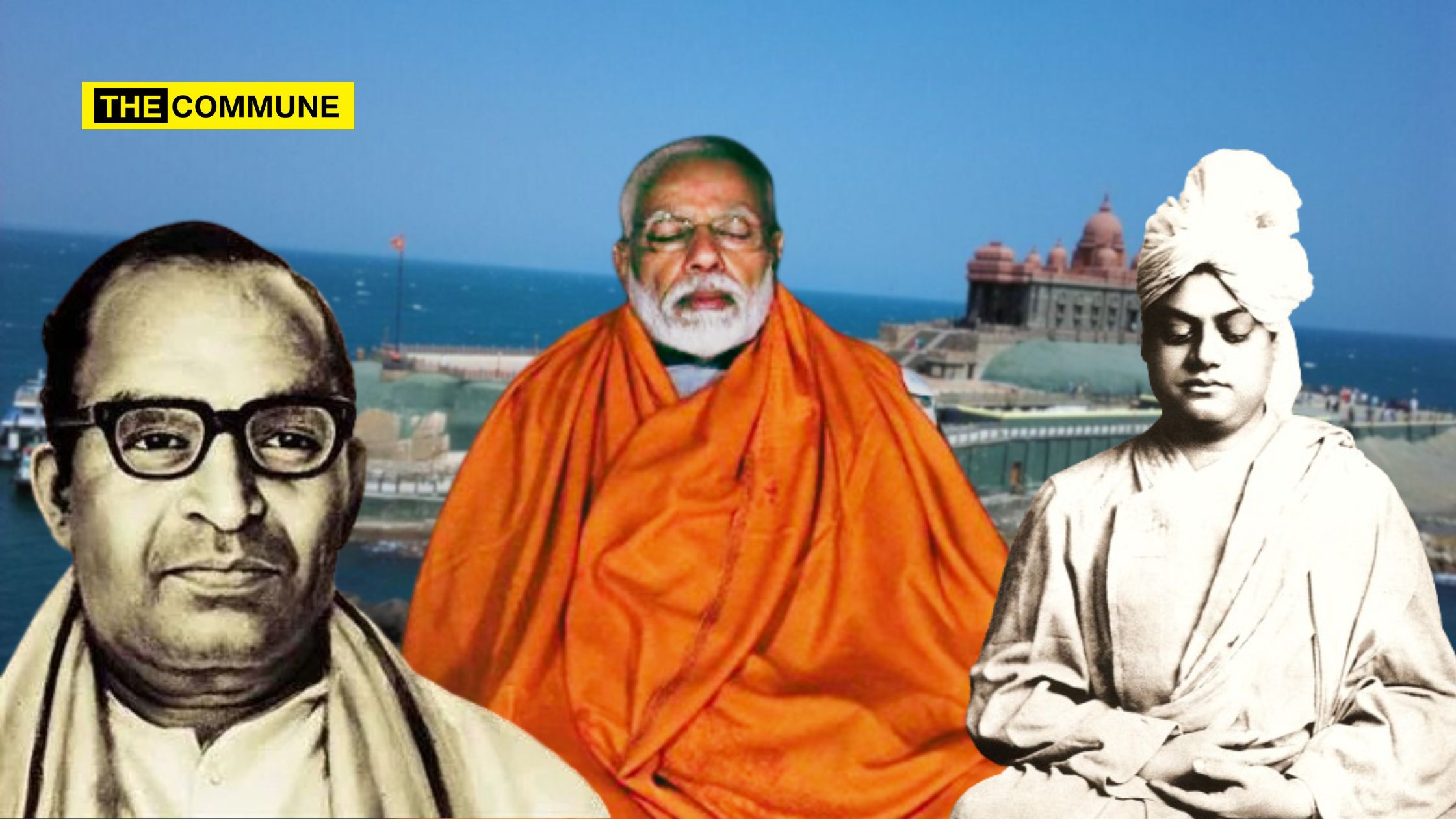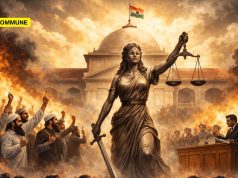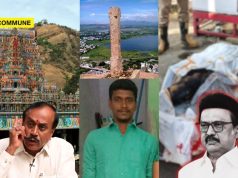
The Indian Prime Minister, Narendra Modi, has planned a three-day meditation retreat in Kanyakumari, Tamil Nadu, starting on 30 May 2024, just before the Lok Sabha poll results are announced on 4 June 2024. His intention to meditate at the Vivekananda Rock Memorial Hall for two days, from 30 May to 1 June 2024, has caused quite a stir among the opposition.
The location holds historical significance as Swami Vivekananda, a renowned philosopher and spiritual leader, achieved enlightenment there in 1892 after meditating for three days. Modi has chosen this same location to mark the conclusion of the BJP’s Lok Sabha election campaign.
This is not an unprecedented move by Modi. During the 2019 election campaign, he spent two days in solitary meditation at the Kedarnath shrine in Uttarakhand. In 2014, he visited Pratapgarh in Maharashtra to pay tribute to Chhatrapati Shivaji, who established the Maratha empire, and set the stage for Hindavi Swaraj, after a significant victory in November 1659.
However, the Congress and Trinamool Congress parties have expressed their discontent, claiming this to be a violation of the model code of conduct. Congress delegates led by Abhishek Manu Singhvi argues that either Modi should meditate after polling hours on 1st of June, or there should be no media coverage of the event until voting concludes. West Bengal Chief Minister Mamata Banerjee has also stated that her party will lodge a complaint with the Election Commission if Modi’s meditation is televised. She argues that any publicity of the meditation would be a breach of the Model Code of Conduct.
The Historical Significance Of Vivekananda Rock
Swami Vivekananda, during his meditation on the islet situated approximately 500 meters from Vavathurai beach in Kanyakumari, envisioned a progressive India. This location, at the southernmost point of mainland India, is where the Indian Ocean, Arabian Sea, and Bay of Bengal converge.
After traversing India for four years, Swami Vivekananda developed his philosophy. It emphasized faith in one’s divine nature and advocated for truth, purity, honesty, perseverance, courage, strength, and love.
In a letter to Swami Ramkrishnananda in 1894 (not to be mistaken with his guru, Sri Ramakrishna), he shared his insights. He wrote, “Seated in Mother Kumari’s temple at Cape Comorin, on the final piece of Indian rock, I conceived a plan. We, as Sannyasins, have been wandering and teaching metaphysics to the people, which is sheer madness. Didn’t our Gurudeva assert, ‘Religion is futile for an empty stomach?’ The brutish existence of these impoverished individuals is solely due to ignorance. We have been exploiting them and oppressing them for centuries” (S P Agarwal’s The Social Role of Gita, 1993).
The Journey To Construct Vivekananda Rock Memorial
The memorial, rich in history, faced numerous obstacles during its construction. Let’s delve into its background and the challenges it encountered.
During one of his nationwide journeys, Swami Vivekananda encountered the Raja of Ramanathapuram, Shri Bhaskara Sethupathi, in Madurai. Despite being raised under British influence after losing his parents at a young age, Bhaskara Sethupathi became a fervent Sanatani and contributed significantly to the Hindu cause. His efforts earned him an invitation to the Parliament of World’s Religions in Chicago. During his visit to Madurai to meet the collector regarding this, he was introduced to Vivekananda by his friend Justice Subramaniya Iyer. After interacting with Vivekananda, Sethupathi felt that Swami was the right person to attend the conference in Chicago and requested him to do so. Vivekananda informed him that he would make a decision about it at the end of his journey and left for Kanyakumari.
In Kanyakumari, there is a rock a bit away from the mainland. It is believed that Devi Bhagavathi (Kanyakumari Amman) performed penance on this rock. The rock, which also bears Devi’s Sri Padams (footprints), is revered by Hindus. On hearing this, Vivekananda swam across the rough sea, reached the rock, and meditated for three days. After returning from Kanyakumari, he informed Sethupathi that he would attend the Parliament of World’s religions in Chicago. Sethupathi made the necessary arrangements. Swami’s speech at Chicago is well-known history. On returning from the US, Swami Vivekananda went to Pamban. Bhaskara Sethupathi received him with full honors and installed a slab at that place. The golden words from Upanishads, ‘Satyameva Jayate’ were inscribed on the slab, which later became the slogan of the Indian Government after it gained independence. Fast forward to 1962.
In 1962, during the centenary year of Swami Vivekananda, a few of the prominent leaders at Kanyakumari decided to build a memorial for Swami Vivekananda on the rock where he meditated. They also decided to construct a bridge from the mainland so that people could easily commute to the rock. They formed a committee for this and the news of this spread rapidly. Some sections of the local fishermen (allegedly Christians) opposed this. They claimed that the rock was ‘theirs’ and suddenly a cross appeared on the top of the rock. The Devaswom Board, which managed the Kanyakumari temple, claimed that the rock was their property. Hindus were upset because the rock was holy to them. Tensions rose on both sides. Suddenly the cross disappeared, and things reached a flash point. The police intervened and the rock came under their control. A judicial probe was ordered. It declared that the rock was indeed ‘Vivekananda Rock’.
The then Tamil Nadu CM, Bhakthavatsalam, told the committee that he wouldn’t allow a memorial to be built. But he would allow a tablet to be installed mentioning that it was Vivekananda Rock. To break the impasse, the committee members agreed to this, and a stone tablet was installed on 17 January 1963.
However, the Ramakrishna Mission was firm in building a memorial. In 1963, they requested Eknath Ranade to take up this work. Eknath was an RSS Karyakarta and at that time he had given up the general secretary post. He was 50 at that time and despite health-related issues, he took up the work. He met the TN CM, Bhakthavatsalam who told him that it was the Union Cultural Minister Humayun Kabir who objected to the memorial as it was a ‘cultural place’. Eknath went back to Kolkata, which was the constituency of Humayun Kabir, and addressed a conference. He informed everyone that it was Kabir who was objecting to a memorial for Vivekananda. Facing a lot of criticism from the press, the minister did a volte-face and told everyone that he was not against the memorial.
Now that the issue was sorted, Eknath went to Delhi to meet the TN CM who was camping there. Luckily, he met Lal Bhadur Shastri who was a minister without a portfolio in Nehru’s cabinet. Shastri advised him to take this slow as a ‘No’ from Bhakthavatsalam would put a lot of hardships. He told Eknath to rally public opinion in support of the memorial. Eknath acted accordingly and collected signatures of 323 MPs in support of the memorial and met Shastri. Delighted by this, Shastri took this to Nehru who readily approved the construction. Nehru also told Eknath that he would speak to Bhakthavatsalam for a go-ahead.
Eknath went back to Bhakthavatsalam who now had no option but to approve the memorial. On the concern of Bhakthavatsalam that the look would be spoiled if there was a bridge from the mainland, Eknath agreed that he would not construct a bridge. The TN CM put another condition that the statue of Vivekananda should be small and also the memorial should also be small with a 15 × 15-foot shrine. He feared that some miscreants might do some damage to the statue/structure and that might lead to a law & order situation. Eknath agreed to that for the time being and approached Kanchi Mahaperiyava with the design. Kanchi Mahaperiyava agreed that the statue should be taller according to the Shilpa Sastra and approved the original design of the memorial which is 130 feet and 1+1⁄2 inches × 56 feet.
Being a devotee of Kanchi Mutt, Bhakthavatsalam couldn’t disagree with this. After a few more struggles and conflicts, the memorial was constructed and declared open in the year 1970. It stands tall as a symbol of Bharath’s national pride, Swami Vivekananda.
In The Words Of Shri Eknath Ranade
The introduction penned by Shri P Parmeswaran, who holds the position of President at Vivekananda Kendra narrates, Eknath Ranade delivered a series of ten discourses on the Rock Memorial, aimed at training the first group of life workers as missionaries of the Kendra. Eknathji’s lectures were divided into two nearly equal parts. The first part dealt with the challenges he faced and how he overcame them to bring the Memorial into existence. The second part focused on his vision for the mission of the Vivekananda Kendra, its philosophy, and ultimate objective.
In the first part, he narrated how he was drawn into the construction of the Vivekananda Rock Memorial (VRM), how various obstacles arose one after another, and how each was overcome until the work was completed and the dream realized. As he narrated incident after incident, the story of the VRM became inseparable from Eknathji’s autobiography. They merged into each other. There was no problem for which he had no solution. To quote his own words: “Every strategy has a counter-strategy, every weapon has a counter-weapon”. This truth was conclusively demonstrated by Eknathji in overcoming the seemingly insurmountable obstacles.
The individuals with whom Eknathji had to contend were not ordinary men. They were leaders in their own right, occupying positions of high power. Bhaktavatsalam was a powerful Chief Minister and Humayan Kabir, a Central Minister. Both were opposed to the monument on the Rock. But Eknathji cleverly outmaneuvered both of them and ultimately won them over to his point of view. He dealt with leaders like Annadurai and Jyoti Basu (not ideological admirers of Swami Vivekananda) successfully and made them partners in the construction of the VRM. This should make even the most experienced experts take a lesson or two from him in the art of human management.
Leaders of every political party, whether in power or in opposition, became willing supporters. Chief Ministers of every state made generous donations toward the VRM. The only Chief Minister who sent Eknathji away empty-handed was the Kerala CM Com. E.M.S. Namboodiripad. Coming out of the interview, Eknathji remarked: “It was like conversing with a sphinx. It was a monologue all the way, on my part. Only an empty stare from the other side”.
It is instructive to know how he made judicious use of various means at his command for the achievement of his end. Both speech and silence were equally effective tools in his hands. To know when to speak and when to keep silent is a rare gift. Eknath Ranade possessed this abundantly. While he raised stormy controversies when necessary, he abstained from them when they served no purpose. He utilized his contact with the Press for raising the right issues at the right time and also not to raise inconvenient issues that would only complicate the situation.
Thus, by bringing into play every God-given quality that he possessed in ample measure, Eknath Ranade was able to successfully accomplish the task that was entrusted to him. While engaged in battle, he was unrelenting and made no compromises – and expected none from the opposite side. But when the battle was over, he saw to it that no bitterness remained. He had the magnanimity to go to his erstwhile opponents and pay compliments to them. He avoided agitations as a matter of principle, because he knew that even if you gain your objective by means of agitations, in the end, there would be no grace in it.
As soon as it became clear to him that the VRM has become an assured fact, he began to think about the second phase. “To put up a Cement & Concrete structure is not the work for which I am born. I am to erect a living & dynamic monument which will be worthy of Swami Vivekananda and which will be capable of bringing into fruition his grand vision of future India” – he began to think. For a close student of the mental make up of Eknathji, it is obvious that the link between the first & second phase, was rooted in organizational & psychological links he had with two great organizations with which he was intimately associated – the RSS & the Ramakrishna Mission. As soon as Guruji Golwalkar expressed to him his desire that it would be good if he took up the challenging task of the construction of the VRM, “from Nagpur I went straight to Calcutta & met with the respected Swami Madhavanandaji to know his mind & seek his blessings”. What did he say? “As a matter of fact, Ramakrishna Mission should have taken up his work, but we can’t deliver the goods. You should certainly take up the work—- you can be rest assured that the entire Mission, will be at your back all the time. Go ahead & Thakur will bless you, Swami Vivekananda will bless you, and you have my blessings also”.
This link had its roots deep in the Psychology of Eknath Ranade. This is clearly evident in his conversation with Sri Govinda Menon, the Home Minister in the Central Cabinet. To a pointed question by the minister as how the work of the RSS could be reconciled with Vivekananda’s philosophy, Eknathji reply was, “It is Vivekananda’s philosophy that made me an RSS worker–. In fact RSS is nothing but an extension of Swamiiji’s work”. The minister was not convinced as it evident from his remark. “It is a very bold statement to make”.
What was the inspiration behind the second phase? What did he actually seek to achieve? It was national reconstruction. Eknathji thought, “If all the religiosity can be converted into activities of public good, there can be all-round national reconstruction”. One very significant dimension of Eknathji’s concept of national reconstruction is that it covered all sections of Hindu society and all parts of the country. He says: “Bhartheeyata in everybody has to be aroused, work should be taken from them.” He firmly believed that “if you scratch sufficiently deep, the Hindu in everybody will be roused, whether one talks of Westernism or Russianism or modernism, he essentially is a child of this soil”.
It is this national vision that took Eknathji to all sections of people during the course of the collection campaign. When the CM of Nagaland questioned him about the wisdom of his spending so much time for a paltry amount, Eknathji’s reply was typical & revealing. He said: “My motive is just not funds. I want your participitation, participation of the Govt and people of Nagaland – because Nagaland is part of the Nation”.
During the course of his campaign for the VRM he had realized that political factionalism & religious sectarianism, had always prevented people from coming together even on issues of national good, about which intrinsically they had no conflicting opinion. Politics being the pursuit of power, could be an instrument of division. But Eknathji was painfully aware that even spiritual movements degenerated into rival sects. As a keen student of history, he found that this had become a national defect with the Hindus and unless it was overcome national reconstruction would remain a mirage. Therefore, he suggested an organization which would be meticulously kept beyond politics & sectarianism.
That was his vision of Vivekananda Kendra. Such an organization could be built up only around a great ideal. Perusing the entire thought of Swamiji, Eknathji discovered that the magic word would be – worship – worship of Man is truly worship of God. But every organization requires Men who are inspired and whose lives are molded by that particular ethos. It is here that Eknathji visualized the creation of a non-sannyasin order of life workers, who will be dedicated to service more than Sadhana. Spirituality must be vibrant. It should be selfless action, rather than simple meditation.
Creation of such an order of life workers was no easy task, considering the prevailing social situation in the country. History of the past many centuries taught Eknathji that the Hindu society has lost its sense of Self-Confidence. They were in the habit of looking for an incarnation to descend save society. What is worse, every great men, who achieved something for the society, was immediately defied and put on a pedestal & worshipped. Eknathji declared that this suicidal trend has to be reversed. He wanted a new generation that believed in themselves, that they can do anything. He accepted Swamiji as an ordinary human being, who raised himself to the highest rung of human evolution, by dint of self-confidence & self-sacrifice.
Eknathji wanted that ideal of Swamiji to be followed by the life workers whom he wanted to man the organization of his dream. So he erected the statue of Swamiji, standing up & starting on his patriotic mission, rather than one, sitting absorbed in deep meditation.
Self-confidence comes from the innate conviction that each man is potentially divine. That was the essence of Hindu heritage from the Vedic times. Eknathji wanted to remind this Vedic mantra – “We are the children of God & immortality”. This realization will automatically give us the super human strength to overcome all fear & weaknesses.
Eknathji realized the importance of teamwork. He reeled off instances after instances from our own history, how a handful of foreign invaders, much inferior to us in every respect, could easily beat us hollow and enslave & rule over us, only because they possessed this great quality of team spirit in abundance, whereas, we Hindus totally lacked this capacity. He pointed out how our Vedic mantras constantly instilled into us this gospel of collective effort – “Yagna”. That made us great in the past.
(With Inputs From esamskriti & X Threads by TS Krishnan)
Subscribe to our channels on Telegram, WhatsApp, and Instagram and get the best stories of the day delivered to you personally.




